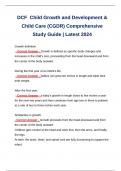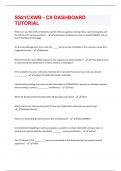DCF Child Growth and Development &
Child Care (CGDR) Comprehensive
Study Guide | Latest 2024
Growth definition
- Correct Answer - Growth is defined as specific body changes and
increases in the child's size, proceeding from the head downward and from
the center of the body outward.
During the first year of an infant's life,
- Correct Answer - babies can grow ten inches in length and triple their
birth weight.
After the first year,
- Correct Answer - a baby's growth in length slows to five inches a year
for the next two years and then continues from age two or three to puberty
at a rate of two to three inches each year.
Similarities in growth:
- Correct Answer - Growth proceeds from the head downward and from
the center of the body outward.
Children gain control of the head and neck first, then the arms, and finally,
the legs.
At birth, the brain, heart, and spinal cord are fully functioning to support the
infant.
,As children grow, the arm and leg muscles develop, followed by the finger
and toe muscles.
Differences in growth:
- Correct Answer - Some children are taller, some shorter. Some children
are smaller, while others are larger.
These differences are completely typical. Typical growth is supported by
good nutrition, adequate sleep, and regular exercise.
Children do not grow at perfectly steady rates throughout childhood.
Children will experience weeks or months of slightly slower growth,
followed by growth spurts.
Differences in the amount of growth can be a source of self-consciousness
for some children.
Because each child is different and special, it is important to help them
understand this concept in order to develop a sense of self-acceptance.
- Correct Answer - It is important to help the children in your care
understand that differences in growth patterns are typical.
Development definition
- Correct Answer - Development refers to an increase in complexity; a
change from relatively simple to more complicated.
Progress
- Correct Answer - Development usually involves a progression along a
continuous sequential pathway on which the child acquires more refined
knowledge, behaviors, and skills.
,Rate varies
- Correct Answer - The developmental sequence is basically the same for
all children; however, the rate of development varies from child to child
Principles of Child Development
- Correct Answer - There are five principles related to the progression of
general development that children will typically experience.
1 - Developmental Sequence is Similar for All
- Correct Answer - Children develop in relatively the same ways.
There is a typical sequence of development that occurs as a child grows.
While the sequence is similar, and the behaviors or skills emerge in the
same order, children can take more or less time with each behavior or skill.
They can move forward, regress for a short time, then move forward again.
Some children may skip a behavior or skill as they move forward.
2 - Development Proceeds from General to Specific
- Correct Answer - Development progresses from a beginning point
moving in a forward direction.
Just as growth of an infant proceeds from the top down and from the center
of the body to the limbs, development of behaviors and skills moves from
general to specific.
As children mature, their bodily changes occur in a sequential order and
give children new abilities.
As the brain and nervous system develop, a child's thinking (cognitive)
skills and motor skills improve.
, In the Physical Development Domain, an infant's large muscles develop
first and result in the ability to wave the arms and kick the legs.
Development continues in the smaller muscles in the fingers and toes, and
results in the ability of the fingers to grasp objects and the toes to help with
balance when standing and walking.
3 - Development is Continuous
- Correct Answer - In children who develop typically, behaviors and skills
they have already acquired become the basis for new behaviors and skills.
There is continuity from one phase of development to the next.
Children continue to add new behaviors and skills as they perfect their
abilities to walk, to write or draw, and to speak. For example, speech
development proceeds from gurgles and coos to chattering, then to words,
then phrases, and finally, sentences. Sentences become paragraphs and
stories, both oral and written.
In order for children to write or draw, they must have developed the control
of their hands and fingers to hold a crayon and pencil. Holding a pencil
develops into writing and drawing.
The continuation of development can easily be seen in children as they
mature from age two to age twelve.
4 - Development Proceeds at Different Rates
- Correct Answer - Each child is different and the rates at which individual
children develop are different.
Although the sequences for development are usually the same for all
children, the rates at which individual children reach each stage will be
different.





